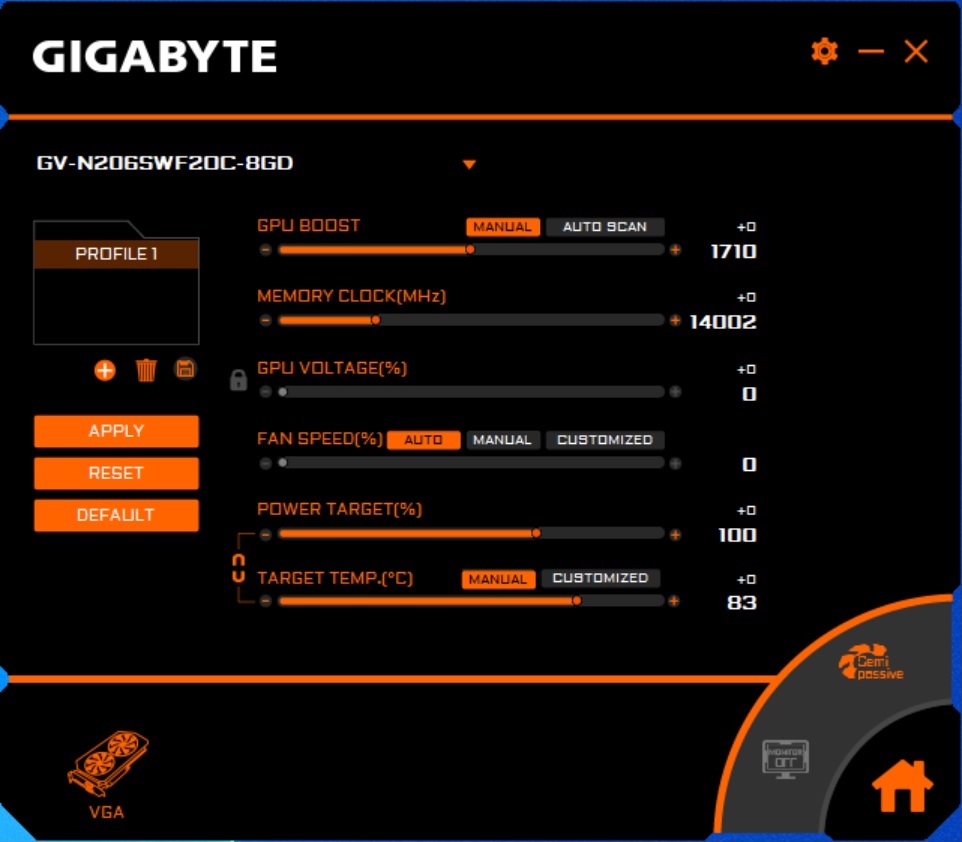Why you can trust Tom's Hardware
Software
Gigabyte’s Aorus Engine software is designed to overclock the video card and adjust fan speeds. What features it has enabled will vary by card. Both of the cards we tested here were capable of being overclocked and controlled through this software, unlike our experience with the AMD-based Gigabyte 5700 XT Gaming OC where overclocking was locked down.
The Aorus Engine software is black and orange, in typical Aorus fashion. The display presents multiple sliders able to control core and memory clocks, voltage (though not on this card), fan speed, as well as power and temperature targets. Users can hit the Auto Scan button for automatic overclocking, or use the sliders to tune things manually.


Aorus Engine is a simple and lightweight application that does the job it’s asked to do. You get full control (as much as the vendor and Nvidia give us these days) over the card for overclocking and fans control as well as being able to create and save custom profiles. One thing this software doesn’t do is any kind of monitoring, which can be a drawback for those who would like to keep track of their GPU temperature, loads, vRAM use, and other items we typically see in hardware monitoring.
Conclusion
Gigabyte’s RTX 2060 cards took Nvidia’s reference design and upgraded the VRMs by both count and hardware quality, as well as using better cooling solutions for reduced noise. On the Gaming OC, the larger fans bring good airflow into the heatsink. Though temperatures were higher on this card, and it was slightly louder than the Windforce model, both cards are quieter than the Founders Edition model. And the Gaming OC delivers the highest performance.
In testing, we saw an average clock speed of close to 1,900 MHz for the Gaming OC. The additional clock speeds allowed this card to be the fastest of the three we tested, though only by a couple of percent at most.
The Windforce OC card, with its dual fans, also brings adequate airflow and works well with the power it needs to manage while also being quiet. Like the Gaming OC, the Windforce also includes an overclock out of the box. Its actual boost clocks in testing averaged 1,854 MHz, again well above the boost clock listed, but below the Gaming OC.
Any of these cards can play games at 1080p using Ultra settings and reaching 60 FPS across every title we have. Most, in fact, are well over 100 FPS and can be considered as a budget high-refresh gaming card. In the end, an RTX 2060 Super of any flavor, be it reference or aftermarket, is capable of driving a 2560x1440 monitor reaching 60 fps or at 1080p with high refresh rates.
Get Tom's Hardware's best news and in-depth reviews, straight to your inbox.

The RTX 2060 Super variants tested perform around 10-20% better than the non-Super 2060 Founders Edition (FE), but just a couple of percent faster than the RTX 2060 Super FE. Pricing for the Gigabyte RTX 2060 Gaming OC and the Windforce OC are listed at $399.99, while the louder, lesser-performing Founders Edition card sells for a whopping $479.39. Note the MSRP for the RTX 2060 Super Founders Edition is $400, so we there is some price gouging from a third party seller going on with the FE card.
On the AMD side, The RX 5700 is several percent behind in performance, but can be found ranging in price from $330 to around $400. The RX 5700 XT is considerably faster (around 15-20%) than the 2060 Super with a price range from $370 to well over $400. That means you can get an AMD card that performs better for a bit less if you shop around.
If the price-to-performance ratio is the primary factor in purchasing, the latest Radeon cards have the advantage. Once the scope is expanded to include power consumption (Nvidia cards use notably less), and if ray tracing capabilities are important, that changes things a bit. You’ll pay a bit more for Nvidia, but get an extra and increasingly substantive feature in dedicated ray tracing hardware, as well as better efficiency.
In the end, Gigabyte’s RTX 2060 Super cards bring better cooling and performance to the table versus the reference cards. When compared to other partner’s RTX 2060 Supers, they are a bit less expensive than most, although Zotac has a $399.99 option as well. If you’re on the hunt for an RTX Super, Gigabyte’s models should be on the shortlist, and if increased performance is more important than power draw, the Gaming OC is the card we’d choose. On the flip side, if efficiency and sound are more important than a few extra fps, the Windforce is a good option as well.
MORE: Best Graphics Cards
MORE: Desktop GPU Performance Hierarchy Table
MORE: All Graphics Content
Current page: Software and Conclusion
Prev Page Power Consumption, Fan Speeds, Clock Rates and Temperature
Joe Shields is a staff writer at Tom’s Hardware. He reviews motherboards and PC components.
-
nofanneeded People should punish nvidia for releasing the RTX Super late .. this should be the real RTX.Reply
I boycotted nvidia after this "super" cheating. what they do is trying to trick AMD , but they dont care about us consumers. MANY people I know who bought the non Super Version switched to AMD and got the Radeon VII. -
N_tell Reply
Why the VII, you could acquire the RTX 2080 s in the same price range, or purchase an RTX 2070s for less. They're, not bad options.nofanneeded said:MANY people I know who bought the non Super Version switched to AMD and got the Radeon VII.